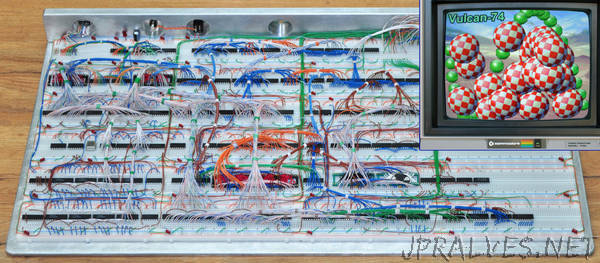
“This project rewinds the clock all the way back to the mid 1970’s, when electronic video games consisted of nothing more than a few moving black and white pixels, and the home computer was still a vision only shared by garage hackers who were willing to connect all of the ICs by hand and then enter their code using toggle switches, watching the results on nothing more than a few blinking LEDs.
Although the immortal 6502 CPU was released in 1975, it did not spawn any of the original home computer greats such as the Commodore PET, Apple II, Atari 8-Bit, VIC-20, C64, BBC, and Acorn until the late 1970’s and early 1980’s. Early video game consoles and arcade games also adopted the affordable 6502 CPU in the late 70’s, the most famous of these being the Atari 2600 Video Game System, released in 1977.
Vulcan-74 is a DIY video game system as well as a complete computer, and it will also be powered by a single 6502 processor. The 6502 CPU will be the only processor on the entire board. All of the other ICs will be only 7400 variant logic gates and basic Static RAMs, which were the same types of ICs that were available in the mid-1970s, and used to create all electronic products from arcade games to aerospace navigation systems. Interestingly, the 6502 is still being manufactured and sold today in multiple packages and formats, including the original 40 Pin DIP as first released so many decades ago.
I am restricting myself to using components that were available before 1980 so that I can make good on a dream project I envisioned when I was only 12 years old, sitting in front of a big old vacuum tube powered color TV, and tapping basic code into my Commodore VIC-20 keyboard. Although I only had a very basic understanding of digital electronics at the time, I still popped open the case to see what type of magic it took to generate this amazing color image on the TV screen. Just 32 ICs inside the VIC, that didn’t look all that complex, so I imagined a system based on the same technology, but with no limit on the number of ICs and amount of RAM.
Although I did sketch up some crude ideas of my “Super VIC”, I didn’t have the knowledge or budget to turn it into reality. At that age, my electronics projects usually only consisted of a few transistors and basic passive semiconductors. Today however, I have both the know-how and the budget to make my 40 year old dream a reality, and I am going to do it using only the technology that was available when I first became inspired by the home computer and all its wonder.
The Vulcan-74 Project will be bound by the following rules…
– Only a single 6502 Processor can be used to control everything.
– All other ICs must be only 7400 series logic or basic Static RAM.
– Video will be NTSC compliant 320×200 with 4096 colors or better.
– Sound will be 4 channels of 8 bit digital samples or better.
– Input will be keyboard and joysticks with some external storage.
– Games and Demos will be coded in 6502 assembly.
– All coding will be done on the actual system itself.
– No circuit board can be used. Everything must be hand wired.
– There is no limit on the number of ICs that can be used.
– The final version will be self-contained in a work of art cabinet.
Looking at the above lofty goals, it is obvious that the final design is going to require somewhere in the neighborhood of 500 ICs, and offer a multimedia experience better than anything that could have been fathomed until the release of the Amiga many years later. Everything I am about to build “could have” been created in late 1970, but the limiting factor would have been cost. RAM was extremely expensive, and gate count pushed up production costs, but I am not limiting myself to either restraint.
Ok, let the journey begin. What follows will be a graphically intensive blog, lasting several years that will include schematics, detailed descriptions of old-school technology, and all accounts of both successes and failures as Vulcan-74 comes to life.”
